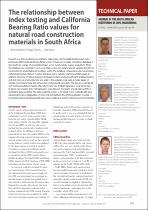 ResearchSpace
ResearchSpace
Relationship between index testing and California Bearing Ratio values for natural road construction materials in South Africa
JavaScript is disabled for your browser. Some features of this site may not work without it.
- ResearchSpace
- →
- Research Publications/Outputs
- →
- Journal Articles
- →
- View Item
| dc.contributor.author |
Breytenbach, IJ

|
|
| dc.contributor.author |
Paige-Green, P

|
|
| dc.contributor.author |
Van Rooy, JL

|
|
| dc.date.accessioned | 2011-03-16T07:59:20Z | |
| dc.date.available | 2011-03-16T07:59:20Z | |
| dc.date.issued | 2010-10 | |
| dc.identifier.citation | Breytenbach, IJ, Paige-Green ,P, and van Rooy, JL. 2010. Relationship between index testing and California Bearing Ratio values for natural road construction materials in South Africa. Journal of the South African Institution of Civil Engineering, Vol. 52(2), pp 65-69 | en_US |
| dc.identifier.issn | 1021-2019 | |
| dc.identifier.uri | http://hdl.handle.net/10204/4906 | |
| dc.description | Copyright: 2010 South African Institution of Civil Engineering | en_US |
| dc.description.abstract | Research was done to determine whether a relationship can be established between index testing and CBR (California Bearing Ratio) results. The process involved compiling a database of test results for a range of rock material types across moist and dry regions in southern Africa. The database was compiled in such a way that it represents natural gravels sampled (mostly) for construction or rehabilitation of road layer works. The database included a location description, material description, Weinert N-value, Atterberg Limits, grading analysis and CBR values. In addition, the linear shrinkage product, shrinkage product, grading coefficient, grading modulus and dust ratio were calculated and also used in the analyses. Data were grouped based on climate, rock material type and compaction, and analysed separately. The data were compared with existing prediction models, after which linear and Weibull regressions were performed to derive new models. Over 130 regressions were derived. The results proved poor and this is ascribed to data variability. The data variability, in turn, is the result of test methods with poor reproducibility and repeatability. In short, the test methods (the CBR in particular) resulted in inconsistent data and subsequently poor results, making accurate predictions nearly impossible. | en_US |
| dc.language.iso | en | en_US |
| dc.publisher | South African Institution of Civil Engineering | en_US |
| dc.relation.ispartofseries | Workflow request;4830 | |
| dc.subject | California bearing ratio | en_US |
| dc.subject | Index testing | en_US |
| dc.subject | Weibull regression | en_US |
| dc.subject | Linear regression | en_US |
| dc.subject | Natural road construction | en_US |
| dc.subject | South Africa | en_US |
| dc.subject | Civil engineering | en_US |
| dc.title | Relationship between index testing and California Bearing Ratio values for natural road construction materials in South Africa | en_US |
| dc.type | Article | en_US |
| dc.identifier.apacitation | Breytenbach, I., Paige-Green, P., & Van Rooy, J. (2010). Relationship between index testing and California Bearing Ratio values for natural road construction materials in South Africa. http://hdl.handle.net/10204/4906 | en_ZA |
| dc.identifier.chicagocitation | Breytenbach, IJ, P Paige-Green, and JL Van Rooy "Relationship between index testing and California Bearing Ratio values for natural road construction materials in South Africa." (2010) http://hdl.handle.net/10204/4906 | en_ZA |
| dc.identifier.vancouvercitation | Breytenbach I, Paige-Green P, Van Rooy J. Relationship between index testing and California Bearing Ratio values for natural road construction materials in South Africa. 2010; http://hdl.handle.net/10204/4906. | en_ZA |
| dc.identifier.ris | TY - Article AU - Breytenbach, IJ AU - Paige-Green, P AU - Van Rooy, JL AB - Research was done to determine whether a relationship can be established between index testing and CBR (California Bearing Ratio) results. The process involved compiling a database of test results for a range of rock material types across moist and dry regions in southern Africa. The database was compiled in such a way that it represents natural gravels sampled (mostly) for construction or rehabilitation of road layer works. The database included a location description, material description, Weinert N-value, Atterberg Limits, grading analysis and CBR values. In addition, the linear shrinkage product, shrinkage product, grading coefficient, grading modulus and dust ratio were calculated and also used in the analyses. Data were grouped based on climate, rock material type and compaction, and analysed separately. The data were compared with existing prediction models, after which linear and Weibull regressions were performed to derive new models. Over 130 regressions were derived. The results proved poor and this is ascribed to data variability. The data variability, in turn, is the result of test methods with poor reproducibility and repeatability. In short, the test methods (the CBR in particular) resulted in inconsistent data and subsequently poor results, making accurate predictions nearly impossible. DA - 2010-10 DB - ResearchSpace DP - CSIR KW - California bearing ratio KW - Index testing KW - Weibull regression KW - Linear regression KW - Natural road construction KW - South Africa KW - Civil engineering LK - https://researchspace.csir.co.za PY - 2010 SM - 1021-2019 T1 - Relationship between index testing and California Bearing Ratio values for natural road construction materials in South Africa TI - Relationship between index testing and California Bearing Ratio values for natural road construction materials in South Africa UR - http://hdl.handle.net/10204/4906 ER - | en_ZA |





